What is a fracture?
A fracture is a partial or complete break in the bone. When a fracture occurs, it is classified as either open or closed. An open fracture occurs when the bone fractures and perforates the skin or the bone is exposed through a large wound. A closed fracture occurs when the bone fractures but does not perforate the skin which is much more common.
Fractures have a variety of names based on the x-ray appearance. Here are a few of the more common types of fractures:
- transverse – the break is in a straight line across the bone.
- spiral – the break spirals around the bone; common in a twisting injury.
- oblique – diagonal break across the bone.
- compression – the bone is crushed, causing the broken bone to be wider or flatter in appearance.
- comminuted – the break is in three or more pieces and fragments are present at the fracture site.
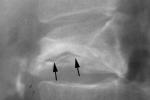
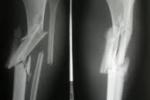
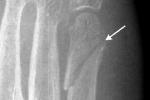
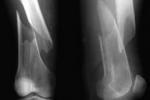
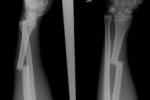
What causes a fracture?
Fractures occur when there is more force applied to the bone than the bone can absorb. This can occur from falls, trauma, or as a result of a direct blow or kick to the body.
What are the symptoms of a fracture?
The following are the most common symptoms of a fracture. However, each individual may experience symptoms differently.
Symptoms may include:
- pain in the injured area
- swelling in the injured area
- obvious deformity in the injured area
- difficulty using or moving the injured area in a normal manner
How is a fracture diagnosed?
Typically an x-ray is all that is needed to evaluate a fracture, however sometimes a CT scan is used to take a better look at the fracture to determine is surgery is necessary.
- x-ray – a diagnostic test which uses invisible electromagnetic energy beams to produce images of the bone that is fractured.
- computed tomography scan (also called a CT or CAT scan) – a diagnostic imaging procedure that uses a combination of x-rays and computer technology to produce a 3 dimensional view of the fracture. CT scans are more detailed than general x-rays.
Treatment for a fracture:
The goal of treatment is to control the pain, promote healing, prevent complications, and restore normal use of the fractured area
Treatment may include:
- splint/cast (immobilizes the injured area to promote bone alignment and to protect the injured area from motion or use)
- medication (to control pain)
- surgery
Surgery may be required to put certain types of fractures back into proper position. Occasionally, internal fixation (metal plates, screws, pins or rods) are used to hold the bone together to maintain proper position. Minor procedures may sometimes be done in the office to “push” the bones into place .
How much pain should I expect ?
Most fracture pain improves after 48 to 72 hours. Pain medication will be prescribed in circumstances where we expect more pain. In the event a minor procedure needs to be performed in the office an injection of local anesthetic “numbing” medication would be used which greatly reduces discomfort. If the procedure needs to be done in the hospital medication is given through the IV, and patients are asleep during the procedure. Again the discomfort for either procedure is greatly reduced after the first 2-3 days.
Will I need a cast?
Most fractures require casting from 4-6 weeks, however the younger the patient the sooner a cast may come off due to increased healing. Some fractures are unable to be casted such as the clavicle “collar bone”. Sometimes a splint is all that is needed to support the fracture. This would be discussed with patient depending on the type of fracture they have.
Do you have waterproof casts?
The fiberglass itself is waterproof however the cast padding underneath is not. With certain casts we may use a waterproof padding which would allow a patient to swim with a cast on. Each situation is different so discuss it with your physician.
What color cast can I have?
We have most colors of the rainbow for you to choose from. You could also decorate the cast with stickers and most importantly have friends and family sign your cast. Having a broken bone is bad enough so have fun with your cast. When the cast is off you can keep it if you wish.
What about gym or sports?
We ask most patients to wait until after the cast is off to return to sports or gym however depending on the type of fracture sometimes a player could return to a sport earlier than expected. Return to play is usually around 6-8 weeks after a fracture, however it depends on the type of fracture you have.
Will it hurt to get my cast off?
The cast saw sounds really loud and looks kind of scary but most patients have no pain with cast removal. The saw itself vibrates very quickly but does not spin like a regular saw which is what makes it safe.
Sometimes patients will even say it kind of tickles!
Click here for more FAQ’s on casts
